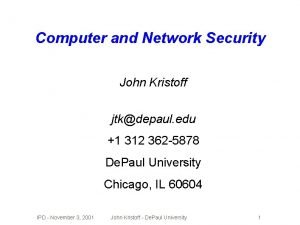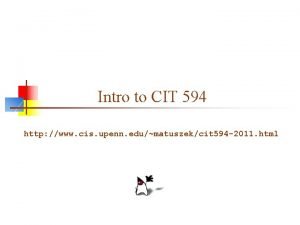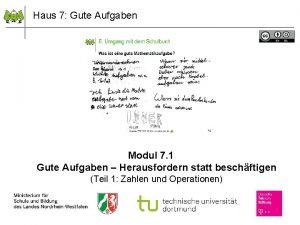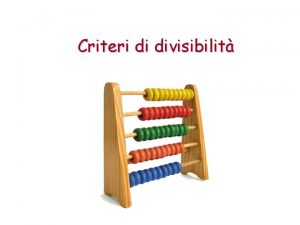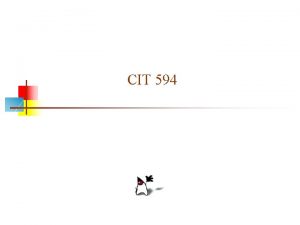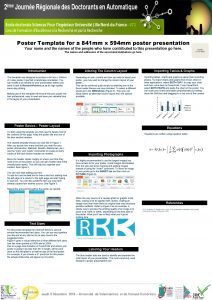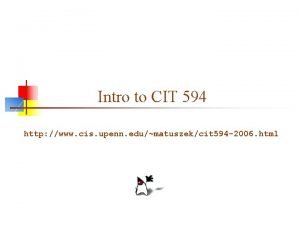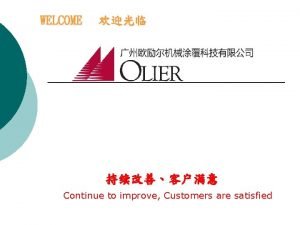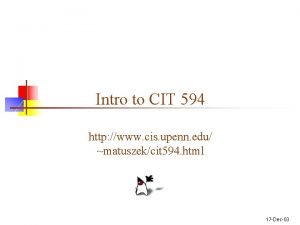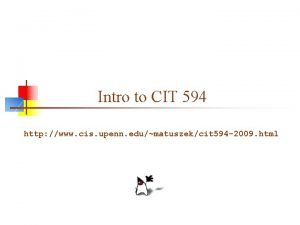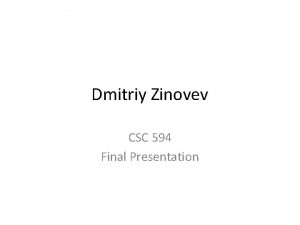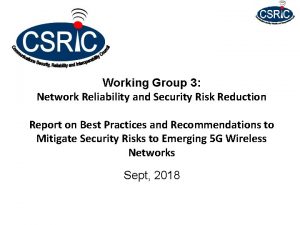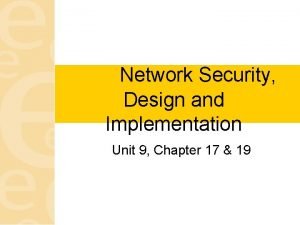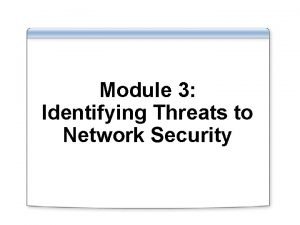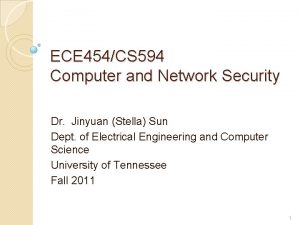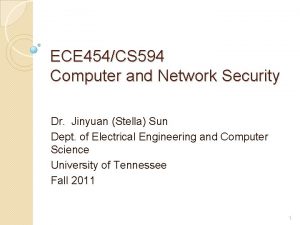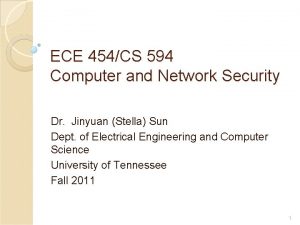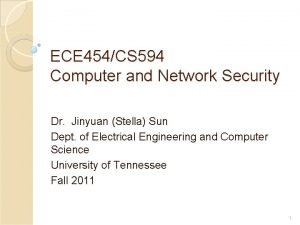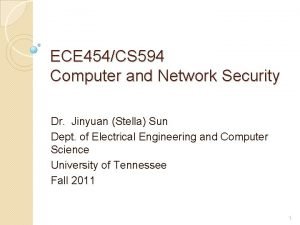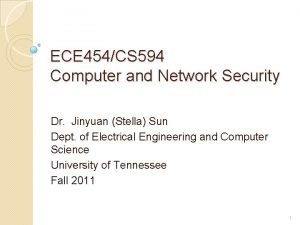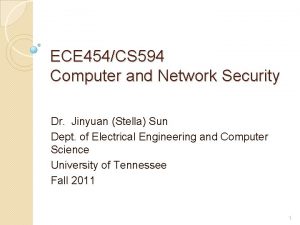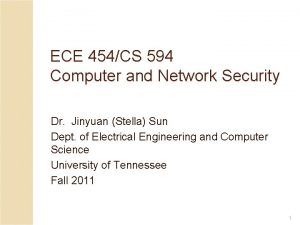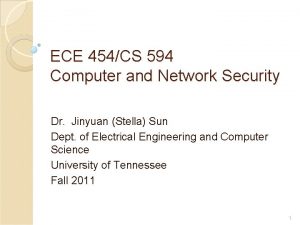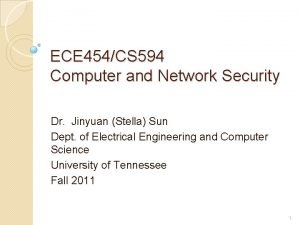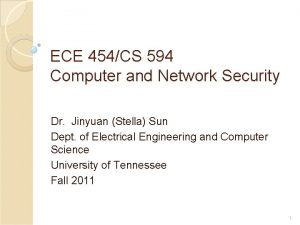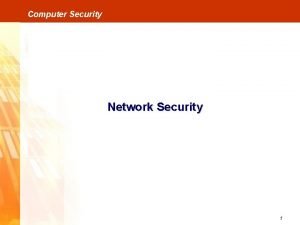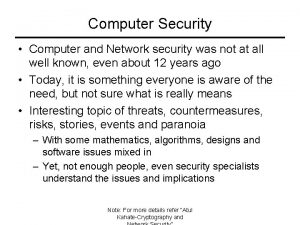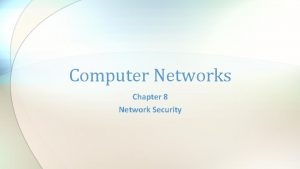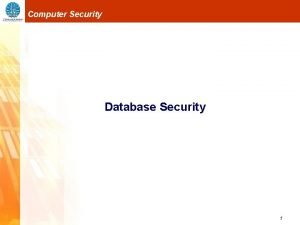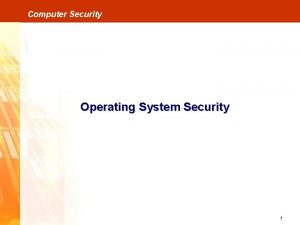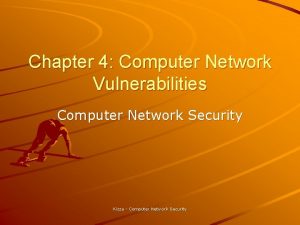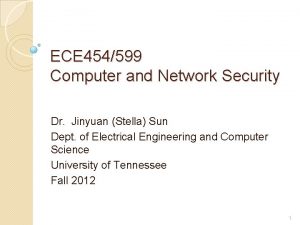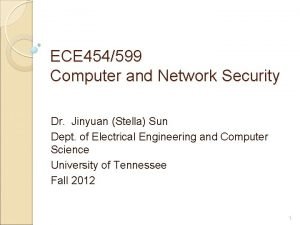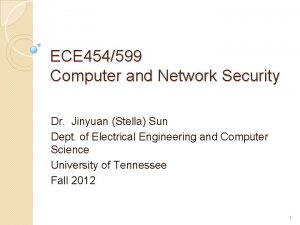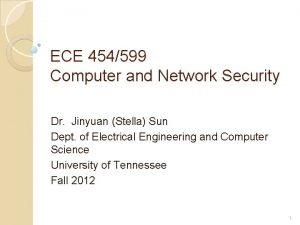ECE 454CS 594 Computer and Network Security Dr





























![Reading Assignment �[Kaufman] Chapter 15 Reading Assignment �[Kaufman] Chapter 15](https://slidetodoc.com/presentation_image_h/855c9353c2fee927c70f73ccdb15077c/image-30.jpg)
- Slides: 30

ECE 454/CS 594 Computer and Network Security Dr. Jinyuan (Stella) Sun Dept. of Electrical Engineering and Computer Science University of Tennessee Fall 2011 1

Public Key Infrastructure PKI Trust Models • Revocation • Directories • PKIX and X. 509 • Authorization •

Authenticity of Public Keys Bo b’s ke y ? Alice private key Bob public key Problem: How does Alice know that the public key she received is really Bob’s public key?

Certificate and CA �Public-key certificate ◦ Signed statement specifying the key and identity �sig. Alice(“Bob”, PKB) �Common approach: certificate authority (CA) ◦ Single agency responsible for certifying public keys ◦ After generating a private/public key pair, user proves his identity and knowledge of the private key to obtain CA’s certificate for the public key (offline) ◦ Every computer is pre-configured with CA’s public key

Using Public-Key Certificates Authenticity of public keys is reduced to authenticity of one key (CA’s public key)

Public Key Infrastructure �The task of PKI is to securely distribute public keys. �PKI consists of ◦ ◦ certificates a repository for retrieving certificates a method of revoking certificates a method of evaluating a chain of certificates from a trust anchor to the target name

Hierarchical Approach �Single CA certifying every public key is impractical �Instead, use a trusted root authority ◦ For example, Verisign ◦ Everybody must know the public key for verifying root authority’s signatures �Root authority signs certificates for lower-level authorities, lower-level authorities sign certificates for individual networks, and so on ◦ Instead of a single certificate, use a certificate chain �sig. Verisign(“Un. B”, PKUT), sig. UT(“Manoel”, PKV) ◦ What happens if root authority is ever compromised?

Alternative: “Web of Trust” �Used in PGP (Pretty Good Privacy) �Instead of a single root certificate authority, each person has a set of keys they “trust” ◦ If public-key certificate is signed by one of the “trusted” keys, the public key contained in it will be deemed valid �Trust can be transitive ◦ Can use certified keys for further certification sig. Alice(“Friend”, Friend’s key) sig. Friend(“Foa. F”, Foa. F’s key) Alice Friend of friend Bob I trust Alice

Chain of Trust �Small World: Any two people in this world can be connected via “six degrees of separation” Alice: Ted’s public key is 135790 [Carol’s public key is 123456] Ted [David’s public key is 789012] Carol [Bob’s public key is 345678] David (Trust anchor)

PKI Trust Model �Answering the following questions. ◦ Where to get trust anchors? ◦ Which chain of trust to follow? �Various models ◦ Monopoly Model ◦ Monopoly plus Registration Authorities ◦ Delegated CAs ◦ Oligarchy ◦ Anarchy Model ◦ Top-Down with Name Constraints ◦ Bottom-UP with Name Constraints

Monopoly Model �Monopoly Model ◦ There is a single CA, which is the trust anchor of all principles. �Monopoly Plus Registration Authorities (RAs) ◦ CA issues certificates, but delegates the verification of keys to RAs.

Delegated CAs �The trust anchor CA generates certificates for delegated CAs, which in turn generates certificates for principles. �More than one certificate is needed in the process of verification of a public key.

Oligarchy Model �Multiple trust anchor CAs are pre-configured in all principals �User has an option to modify the list of trust anchor CAs �Commonly used in browsers (SSL/TLS)

Anarchy Model �Each principal selects a set of peers as trust anchors; Principals sign each others’ certificates. �A principal may store a database of known certificates; Some organization may offer public repository of certificates. �If a chain of trust (certificates) can be found from a trust anchor to a target name, then the public key of the target is verified.

Top-Down with Name Constraints �Name constraints: each CA only trusted for signing a subset of users. �Similar to DNS hierarchy, each domain may have a CA server. The CA of the parent domain (utk. edu) generates certificates for the CAs responsible of the sub-domains (eecs. utk. edu). �Each principal is pre-configured with the public key of the root. �The only trust path is from the root to the target.

Bottom-Up with Name Constraints �A parent CA and a child CA generate certificates for each other. � Two CAs without parent-child relationship may generate a certificate, known as a cross-certificate. � The trust paths start from a trust anchor, follow uplinks to an ancestor, possibly follow a cross-link, then follow down-links to the target.

Directories �A directory is a distributed hierarchical database indexed by a hierarchical name, where associated with each name is a repository of information for that name. �E. g. , DNS, X. 500

PKIX and X. 509 �X. 500 (Directory standard) defines a hierarchical naming scheme. �X. 509 defines the format of certificates, using X. 500. �PKIX defines the trust model, and specifies which X. 509 options should be supported: an architecture of entities (users, CAs, RAs…) and interrelationships (registration, certification, CRL publication)

X. 509 Authentication Service �Internet standard (1988 -2000) �Specifies certificate format ◦ X. 509 certificates are used in IPSec and SSL/TLS �Specifies certificate directory service ◦ For retrieving other users’ CA-certified public keys �Specifies a set of authentication protocols ◦ For proving identity using public-key signatures �Does not specify crypto algorithms ◦ Can use it with any digital signature scheme and hash function, but hashing is required before signing

X. 509 Certificate Added in X. 509 versions 2 and 3 to address usability and security problems

Certificate Revocation �Revocation is very important �Many valid reasons to revoke a certificate ◦ Private key corresponding to the certified public key has been compromised ◦ User stopped paying his certification fee to this CA and CA no longer wishes to certify him ◦ CA’s certificate has been compromised! �Expiration is a form of revocation, too ◦ Many deployed systems don’t bother with revocation ◦ Re-issuance of certificates is a big revenue source for certificate authorities

Certificate Revocation Mechanisms �Online revocation service (OLRS) ◦ When a certificate is presented, recipient goes to a special online service to verify whether it is still valid �Like a merchant dialing up the credit card processor �Certificate revocation list (CRL) ◦ CA periodically issues a signed list of revoked certificates �Credit card companies used to issue thick books of canceled credit card numbers ◦ Can issue a “delta CRL” containing only updates �Question: does revocation protect against forged certificates?

X. 509 Certificate Revocation List Because certificate serial numbers must be unique within each CA, this is enough to identify the certificate

X. 509 Version 1 “Alice”, sig. Alice(Time. Alice, “Bob”, encrypt. Public. Key(Bob)(message)) Alice Bob �Encrypt, then sign for authenticated encryption ◦ Goal: achieve both confidentiality and authentication ◦ E. g. , encrypted, signed password for access control �Does this work?

Attack on X. 509 Version 1 Attacker extracts encrypted password and replays it under his own signature “Alice”, sig. Alice(Time. Alice, “Bob”, encrypt. Public. Key(Bob)(password)) Alice � Receiving Bob “Charlie”, sig. Charlie(Time. Charlie, “Bob”, encrypt. Public. Key(Bob)(password)) encrypted password under signature does not mean that the sender actually knows the password! � Proper usage: sign, then encrypt

Authentication and Authorization �Authentication: verify who you are. �Authorization: restrict what you can do.

Authorization �Access Control List (ACL) ◦ Given a resource, the ACL specifies which user can have what rights in accessing the resource. �Capability List ◦ Given a user, the capability list specifies what resources the user can access and what are the right for each resource.

Groups and Roles �Groups ◦ A way to remove redundancy in ACLs or capability lists. �Roles ◦ A different way of removing redundancy, other than groups. ◦ Establish a context for a user to perform his tasks.

Summary �Trust: PKI trust models - how to find trust anchors (CA, peer) - how to establish chain-of-trust �Certificate: proof of trust - what is a certificate - why is it needed - format: X. 509 - revocation: needed whenever a credential is issued
![Reading Assignment Kaufman Chapter 15 Reading Assignment �[Kaufman] Chapter 15](https://slidetodoc.com/presentation_image_h/855c9353c2fee927c70f73ccdb15077c/image-30.jpg)
Reading Assignment �[Kaufman] Chapter 15
 Wireless security in cryptography
Wireless security in cryptography Security security security
Security security security Computer and network security
Computer and network security Osi security architecture in network security
Osi security architecture in network security Security guide to network security fundamentals
Security guide to network security fundamentals Electronic mail security in network security
Electronic mail security in network security Security guide to network security fundamentals
Security guide to network security fundamentals Security guide to network security fundamentals
Security guide to network security fundamentals Computer & network security
Computer & network security Topology in computer
Topology in computer Cit 594
Cit 594 Umkehrzahl
Umkehrzahl I numeri divisibili per 9
I numeri divisibili per 9 Cit594
Cit594 841*594
841*594 Introtocit
Introtocit Magni 599
Magni 599 Ai 594
Ai 594 Cit upenn
Cit upenn Cit upenn
Cit upenn Com(2020) 594 final
Com(2020) 594 final Electronic commerce security
Electronic commerce security Nist frame
Nist frame Network design and implementation
Network design and implementation Module 3: information and network security
Module 3: information and network security Cryptography and network security 6th edition
Cryptography and network security 6th edition Introduction to network security and cryptography
Introduction to network security and cryptography Number theory in network security
Number theory in network security Firewall base layer
Firewall base layer Authentication in cryptography and network security
Authentication in cryptography and network security Intruders in cryptography and network security
Intruders in cryptography and network security








